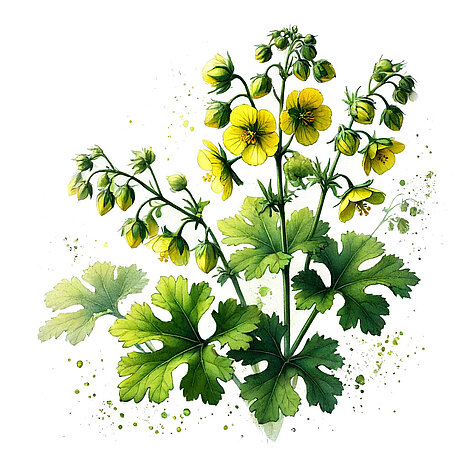Celandine

Celandine, a wild herb often found unnoticed along the roadside or in gardens, holds a complex mix of possibilities and risks for our four-legged friends. This herb, scientifically known as Chelidonium majus, has a long history in folk medicine, but its effect on dogs deserves a closer look. In this article, we'll look at celandine from all angles, from its characteristic features to the potential benefits and drawbacks for dogs.
What is celandine?
Celandine belongs to the poppy family(Papaveraceae) and is native to Europe and parts of Asia. It is characterized by its bright yellow flowers and the distinctive orange milky sap that oozes out when the stem or leaves are damaged. In traditional medicine, celandine is prized for its supposed healing properties for a variety of ailments, from digestive problems to skin conditions.
The benefits of celandine
Traditional uses
In human folk medicine, celandine is valued for its antispasmodic, antimicrobial and choleretic (stimulating bile production) properties. It has been used to treat liver and gallbladder problems and to relieve skin rashes and warts.
Possible positive effects on dogs
Some alternative veterinary practitioners use celandine in very dilute doses to treat similar ailments in dogs, particularly liver and gallbladder conditions. There are also reports of topical use for certain skin conditions.
The disadvantages and risks for dogs
Toxicity
Despite its traditional use, it must be emphasized that celandine contains numerous alkaloids that can be potentially toxic to dogs. Symptoms of poisoning can include vomiting, diarrhea, lethargy and, in severe cases, liver and kidney damage.
Lack of scientific evidence
There is limited scientific research on the efficacy and safety of celandine in dogs. Most information is based on anecdotal reports and traditional medicine, which means that the exact effects and safe dosage are largely unknown.
The danger of self-medication
Self-medicating dogs with celandine, especially without the guidance of an experienced veterinarian, carries significant risks. Incorrect dosages can lead to poisoning, and the use of celandine could exacerbate existing health problems or delay diagnosis and treatment by a professional.
Beware of the green wolf in sheep's clothing
Celandine, an herb with a long history in folk medicine, is a double-edged sword when it comes to the health of our dogs. While it may offer potential benefits, the risks and uncertainty surrounding its safety and efficacy outweigh the benefits. Our dog's health should not be based on guesswork. It is important to seek professional advice for any health issues and refrain from self-medicating with insufficiently researched herbs. Nature offers many wonders, but not everything natural is safe for our faithful companions.
If you notice any signs of hypersensitivity or poisoning in your dog, you should see your vet immediately. We are not a substitute for a vet, but we try to be as accurate as possible. Every dog reacts differently and we recommend you get a second opinion or consult your vet if in doubt.
Stay healthy and take good care of your four-legged friend!😊